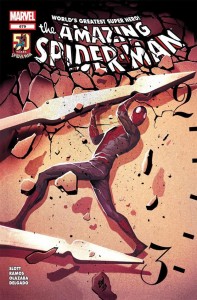 God knows that The Amazing Spider-Man isn’t perfect – it gets sucked into events like most Big Two publisher books, and sometimes it uses valuable page real estate setting up the next event – whatever the hell that winds up being. But when it’s not being co-opted and fucked with by higher Marvel editorial for whatever crossover event the Architects bake up at their retreats (“I’ve got it! X-Men kick the Fantastic Four in the groin! Let’s try it on new guy Hickman! Hold him down, Aaron, or you’re next!”), it is one of the best, old-school comics you can get.
God knows that The Amazing Spider-Man isn’t perfect – it gets sucked into events like most Big Two publisher books, and sometimes it uses valuable page real estate setting up the next event – whatever the hell that winds up being. But when it’s not being co-opted and fucked with by higher Marvel editorial for whatever crossover event the Architects bake up at their retreats (“I’ve got it! X-Men kick the Fantastic Four in the groin! Let’s try it on new guy Hickman! Hold him down, Aaron, or you’re next!”), it is one of the best, old-school comics you can get.
Amazing Spider-Man #679 is the second part of a two-and-out that at face value has no place in a book about a guy who, in his best stories, fights more street-level crime than cosmic stuff. If you’d told me that writer Dan Slott was going to do a story about Spider-Man that included time travel, continuity paradoxes and Madame Fucking Web, I’d have said that was stupid, and you were stupid for saying it.
But Slott takes those elements and does the smart thing with them: use them as simply a catalyst for the rest of the story. The entirety of the time travel involvement is to show the stakes – the destruction of New York by a certain time – if Spider-Man can’t figure out what to do… and he does those things where Spidey should: on the streets.And after months and months of seeing Spidey battling Thor knockoffs in the Avengers, and traveling to other dimensions in FF, it’s nice to see Spider-Man just stomping dudes in an alley with a wisecrack for a change.
So in a story that could go Full FF (And actually, just stopping to think about it now, why didn’t Spider-Man call Reed Richards in a time door / end of the world scenario? My guess? Reed Richards puts new hires on a 90-day probation period, and if you ask for help? Yer spending a week swamping The Thing’s toilet. Reed Richards is a dick boss.), instead Slott puts Spider-Man out on the street, looking for some old school asses to kick – I mean, who gets tired of seeing Flagsmasher take a beating? If only for his name (“Flags are cloth!” THWACK! “Cloth is notoriously difficult to smash!” WHAP! “Your name therefore describes an event that is highly improbable!” BLAP! “You’d do just as well calling yourself Glassripper!” DWORPTH! “And a robot arm seems like the least likely way to eliminate a nation state!” GOOP! The Thing’s toilet is that way! And he ate eggs and beets yesterday!” SPLAT!
The art by Humberto Ramos is not something that’s generally to my taste. As I’ve said before, his style tends toward a manga look – big eyes, heavily stylized figures, and emotionally exaggerated facial expressions – there’s a panel where Spidey hits Flagsmasher where Ramos draws Flagmasher’s gape-jawed expression of surprise making him look like he’s a set of kneepads away from taking on the New York Giants secondary (Go Patriots!). But even so, Ramos’s style is starting to grow on me on this book; considering Spider-Man’s mask has no face, Ramos’s blowjob faces don’t get in the way, and his skinny, angular managa-style figures generally complement how you’d expect Spidey to look. It’s still not a style I’d go out of my way to buy in Artists’ Alley, but its far less invasive to me on Spider-Man than it was back when Ramos was on, say, Wolverine, where a giant-eye, knob-mouthed Logan made me occasionally wake up screaming.
This is a fun comic book, and, unlike say, Invincible, doesn’t require you to know a whole bunch of backstory to jump right in. After so many big event books, and the long opening arcs of DC’s New 52 that are just now starting to wrap up, it’s refreshing as hell to see a self-contained two-issue arc that is just a good time to read, and even finds time to remember that the personal life of Peter Parker is just as important to readers as Spider-Man fighting… but not as important as stomping the shit out of Flagsmasher (“Your name was clearly not very well though out!” GORP!).
This book is a good time. Check it out.
 Podcast RSS Feed
Podcast RSS Feed iTunes
iTunes Google Play
Google Play Stitcher
Stitcher TuneIn Radio
TuneIn Radio Android
Android Miro Media Player
Miro Media Player Comics Podcast Network
Comics Podcast Network